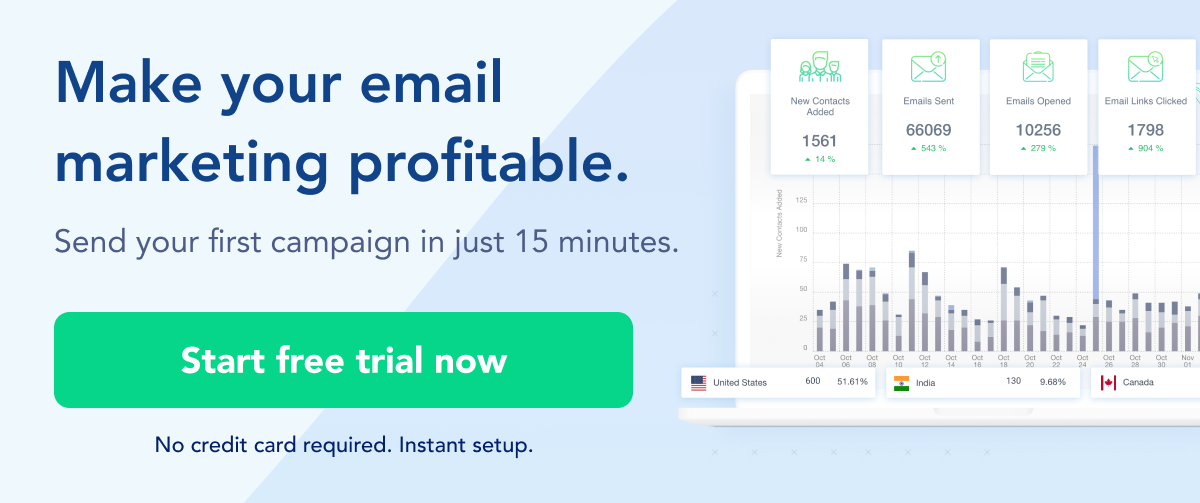
The 5 Types Of Lifecycle Email Marketing [With Examples]
Marketing is no longer restricted to the prime location billboards or prime time television adverts. It has long since evolved past the transactional efforts to maximize sales. Today, marketing has a longer lifecycle — one that begins with the customer’s awareness and ends with earning and sustaining their loyalty.
It has multiple channels — social media, SEO, online advertising, influencer, email; also and within those channels multiple touchpoints. It takes longer to convert a customer, however, once converted, the customer remains loyal longer than they ever have in the past. This is the power of lifecycle marketing.
Table of Contents
Email marketing, which is one of the oldest forms of digital marketing also moved into the lifecycle bandwagon.
The typical marketing lifecycle follows the AIDA model, where it moves from Awareness -> Interest -> Desire -> Action.
In lifecycle email marketing, it is almost the same but with a slight difference. Although it begins with Awareness, it has multiple touchpoints in between that make it complicated and also gives adequate opportunities for building customer loyalty.
- Awareness — Awareness about your offerings that are created through cold outreach emails
- Knowledge — Building understanding about the product capabilities through informative and educational product information content
- Consideration — Building interest in buying your offerings
- Selection — Creating the final push to select your offerings above other competitive offerings
- Purchase — Setting the stage for the successful purchase of the offering
- Satisfaction — Ensuring thorough satisfaction of the product through proactive customer care and feedback gathering
- Retention & Loyalty — Ensuring customer loyalty through upselling, cross-selling, and loyalty activities
- Word of Mouth — Using happy customers as mouthpieces for spreading the good word about the product
The Many Types of Emails Used in Email Lifecycle Marketing
As is understood from the above, there is not a single email that can convey the message to the customer. Multiple types of emails are required to constantly connect with the customer and nudge them towards the decision of making a purchase and remaining loyal to the brand.
To achieve that, one needs:
- Onboarding emails
- Subscriber emails
- Promotional emails
- Transactional emails
- Behavioral emails
Now let’s take a look at each of these types of emails and also some of the brands from whom you can take inspiration.
1. Onboarding emails
Onboarding emails are typically used for initiating the customer into the product. They give intimation to the customers when they have signed, guide them towards their accounts, show around the process to use the product, and so on.
Activation emails that you get in your inbox immediately on signing up for an account or service fall under this category. Although they are meant for informational purposes, they are also critical to user engagement. The team at SolitaireBrain, for example, found that their solitaire game of the day was played 30% more after they started sending onboarding emails.
There are countless brands that are doing a fine job with their welcome emails. But, if there is one that creates a great first impression it has to be National Geographic. Their welcome email is filled to the brim with great content that hooks audiences and makes them spend consuming it completely. Their welcome emails usually end nudging the user towards specific content related to photography, travel planning, or family activities.

2. Subscriber emails
Subscriber emails are typically used to build and maintain a subscriber list. The list could be later used for distributing the latest content, like blogs, whitepapers, eBooks, etc. to the customers or be further used for email marketing. Subscribers’ emails also help in retargeting your existing customers who have given explicit information about their preferences, wants, goals, and so on.
Here is how Monday.com — a team collaboration and productivity enhancement tool sends its subscriber emails.
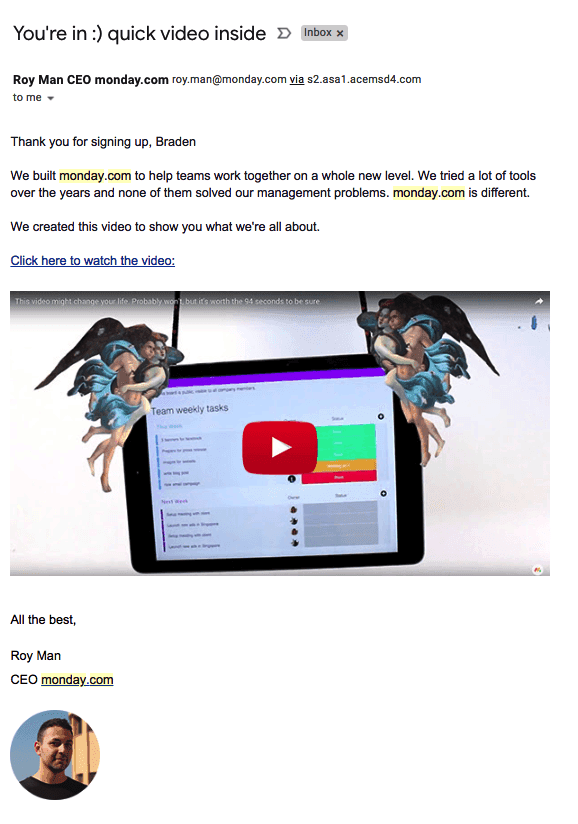
As you can see in the email, it has a nice catchy line that is welcoming and makes the reader feel it is directed at them. Also, the email body also flows nicely like a conversation. The embedded video gives content for the reader to consume and get acquainted with the product. The final conclusion with an image of the SEO gives the email and the brand a face to relate to. All of this significantly increases the chances of user engagement.
3. Promotional emails
Promotional emails as the name suggests are used for promoting a product or service. Most often, they also include a discount, a promo voucher, or some concession meant to drive immediate sales or conversion. They form a crucial part of the overall digital marketing plan that wants to convert users along with building a relationship.
When promotional emails are not executed properly, users will simply discover how to block these unwanted emails. This could potentially detrimentally impact your entire mailing list that you painstakingly built.
Although promotional emails are transactional in nature, if used properly they can also be used to ensure customer loyalty and engagement. Take, for example, Airbnb. The travel aggregator sends emails suggesting the prime properties in locations that the traveler is heading to.
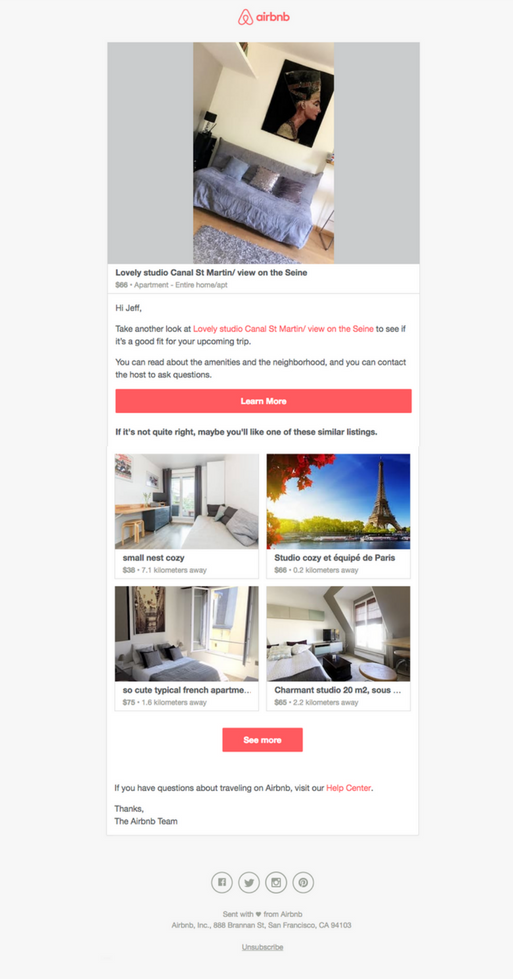
The emails stand out in several ways. To begin with, it directly proposes a property that the user would be interested in the destination that he/she is traveling to. Second, it also offers alternative suggestions that can help the user make a better choice. Additionally, it also takes the user to more Airbnb properties that are personalized to the user’s destination. This is perhaps one of the classic examples of promotional email campaigns.
4. Transactional emails
Transactional emails are used to intimate the user of specific transactions. For example, a new booking, creation of a support ticket, change in password, password request update, opt-in emails, subscribe/unsubscribe emails, order in online shopping, and so on.
Transactional emails do the task of providing reassurance to the user that their action has been completed or a request has been raised. Transactional emails ensure that no activity is happening without the user’s knowledge.
Let’s take a look at how Slack does it. Most Slack users remain logged into the application. However, when there is a need to reset the password, Slack sends this transactional email to the user.
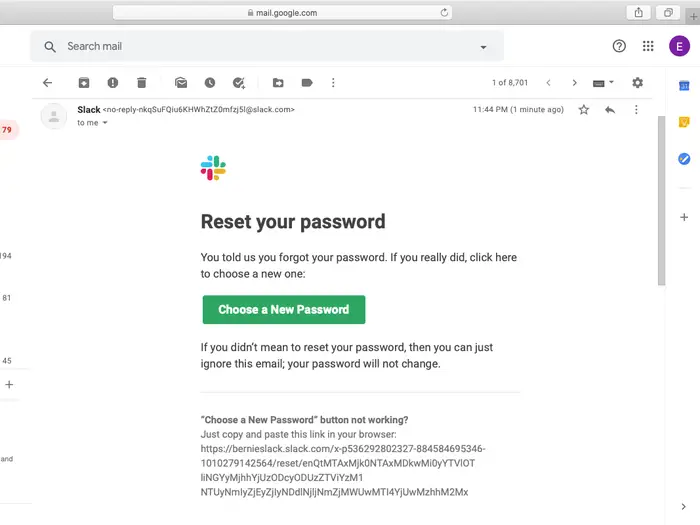
These transactional emails also help keep a record of the activities that the user carried out. In case of any discrepancies, they can be used as a trail to set things back to their previous condition.
5. Behavioral emails
Emails that resonate with typical user behaviors are known as behavioral emails. They are usually automated and are personalized based on a bigger segment of users. The purpose of behavioral emails is to budge the user into interacting with your website or service in a specific manner.
In eCommerce, this would be emails that follow up with customers who abandoned their carts with items in them. In banking, this could be an email for a failed transaction with a link that takes the user to repeat the same transaction. In marketing, this could be a review request email following a successful order.
The options are endless in behavioral emails. Here is an example that could be familiar to you: a shopping cart abandonment email.
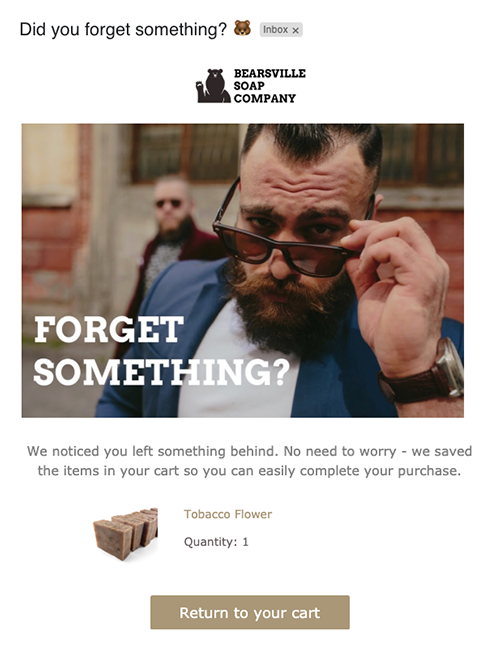
Most behavioral emails like the cart abandonment email have a prominent CTA attached to them. The CTA ensures that the user is taken back to the order completion page where they can complete the order. In other words, it helps in playing to the customer’s usual behavior of abandoning the order and then picking it up later.
The Need for Lifecycle Email Marketing
It is natural for anyone to question the need for lifecycle email marketing. Shouldn’t one email do the task of every other email? Why exert so much effort and time to build an email workflow across the customer lifecycle.
Turns out, the need is real and necessary. Unlike the customers of yesterday, millennial customers are keener to make informed decisions. They want information available at hand before they make a decision, especially one that involves spending their hard-earned money.
That calls optimizing the customer journey across the lifecycle, right from awareness until purchase and into loyalty. This makes lifecycle email marketing a necessity.
An email marketing strategy that traverses across the lifecycle of the user has a better chance of being responded to or even concluding in a purchase. Do keep in mind that emails serve a lot of other purposes other than just making a purchase. Transactional and behavioral emails inform customers about their completed orders, purchases, and transactions. They are also equally important in the customer lifecycle as much as promotional emails.
Email marketing is a tricky affair. However, it is rewarding. Studies have proven that it can give up to 42x return on the investment. To attain such high returns one must be willing to optimize every single touchpoint of the user’s email journey in the best fashion possible. Right from onboarding to everyday transactional emails, the user’s experience and need must be borne in mind.
FAQs
1) What is lifecycle email marketing?
In lifecycle email marketing, there are multiple touchpoints in between that make it complicated and also gives adequate opportunities for building customer loyalty. And it works in the model of Awareness -> Knowledge -> Consideration -> Selection -> Purchase -> Satisfaction -> Retention & Loyalty -> Word of Mouth.
2) What is the need for lifecycle email marketing?
Unlike the customers of yesterday, millennial customers are keener to make informed decisions. That calls optimizing the customer journey across the lifecycle, right from awareness until purchase and into loyalty. This makes lifecycle email marketing a necessity.
3) What are the types of email used in lifecycle email marketing?
The various types of email used in lifecycle email marketing are: onboarding emails, subscribers emails, promotional emails, transactional emails, and behavioral emails.
4) What is the importance of transactional and behavioral emails?
Transactional and behavioral emails inform customers about their completed orders, purchases, and transactions. They are also equally important in the customer lifecycle as much as promotional emails.



